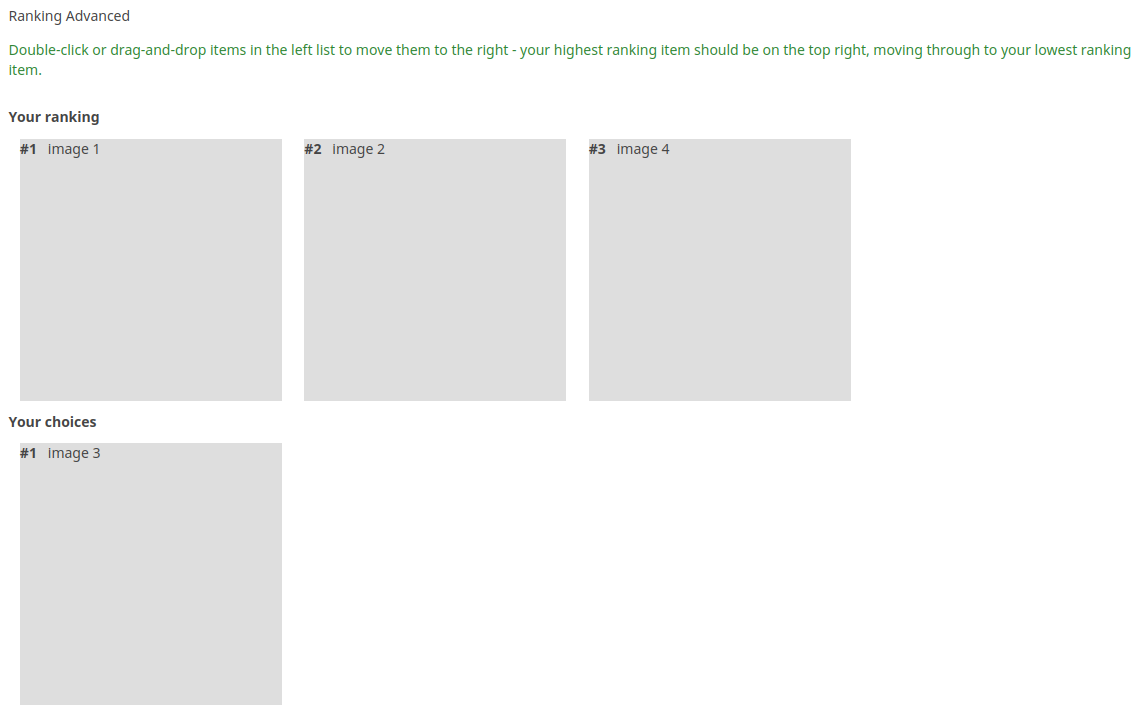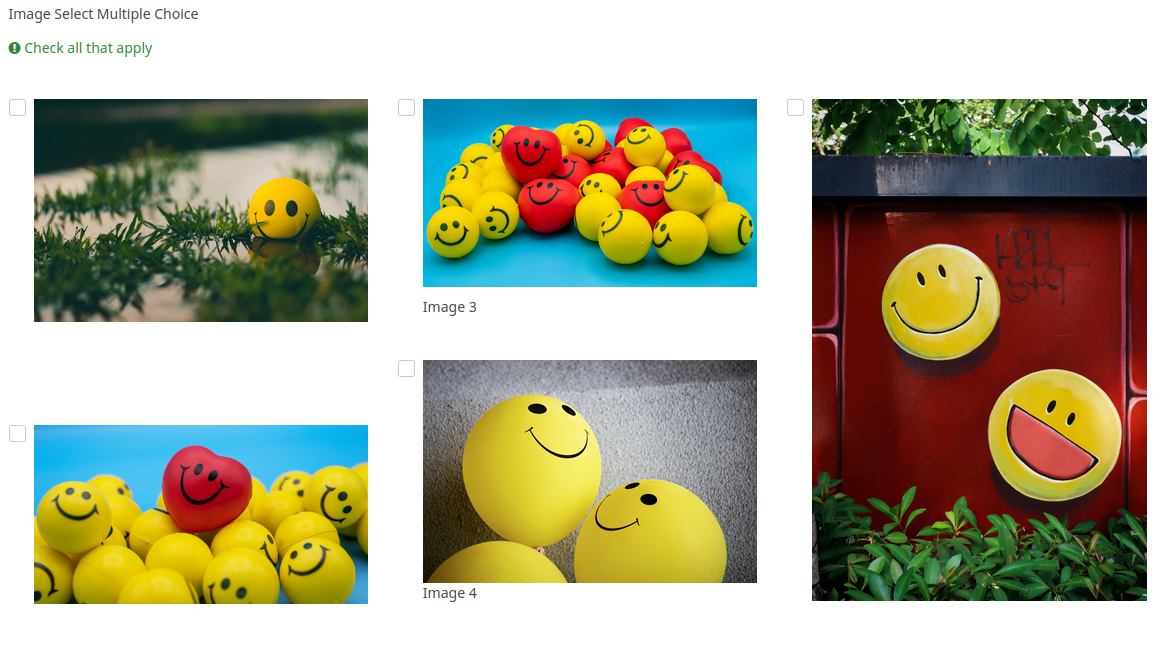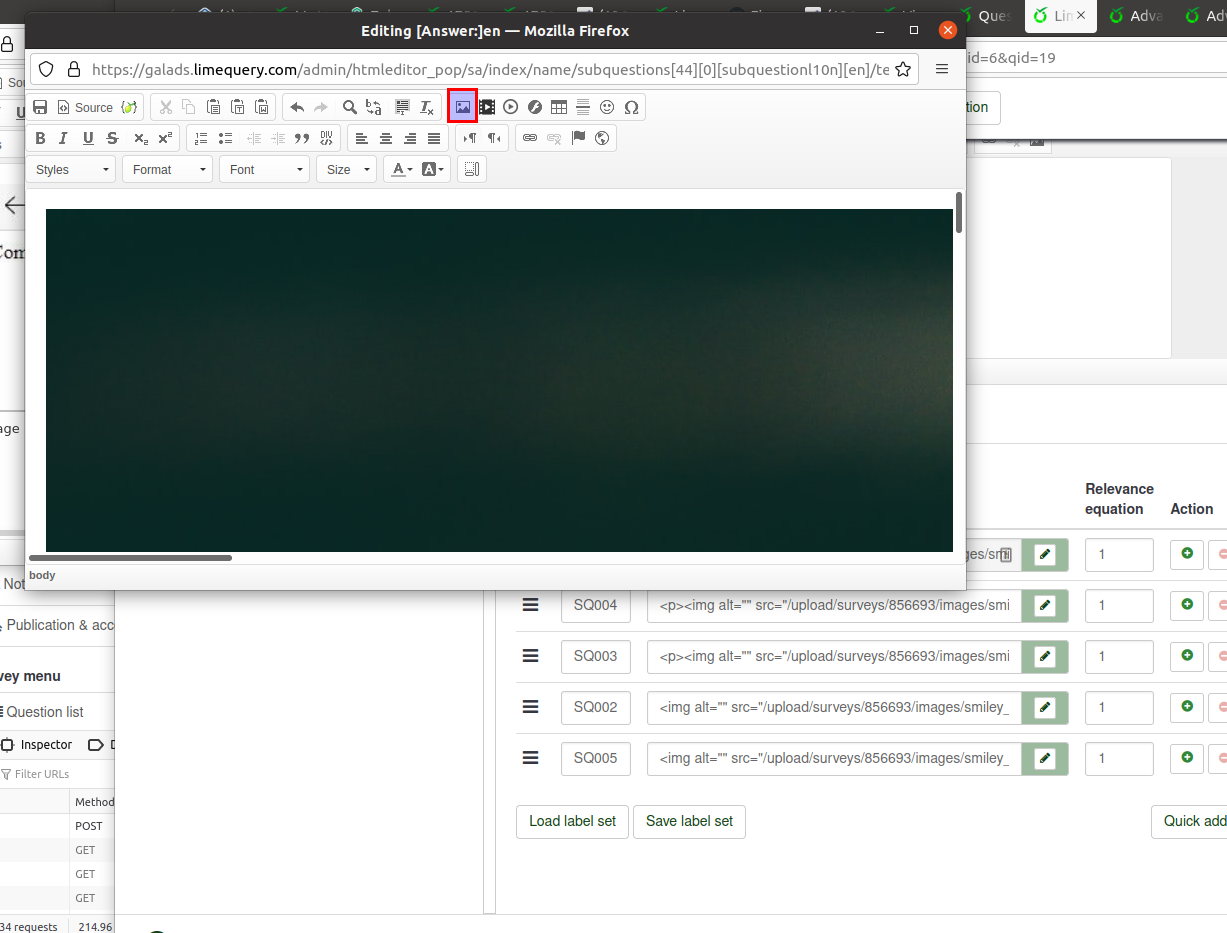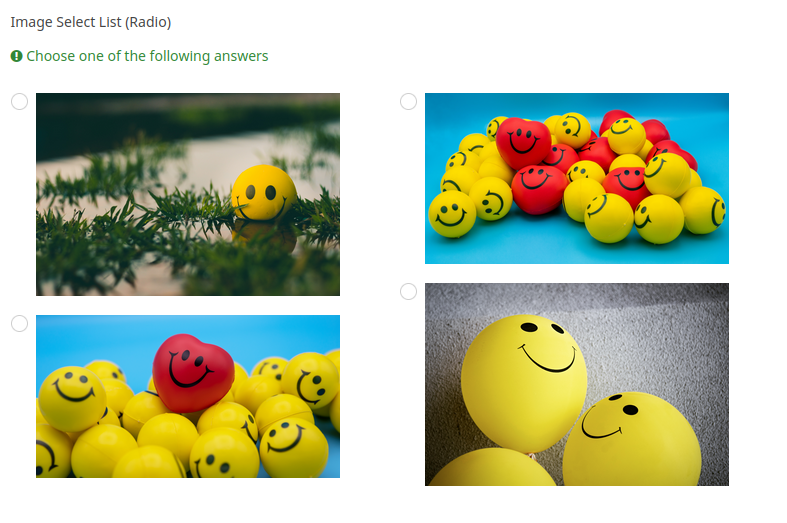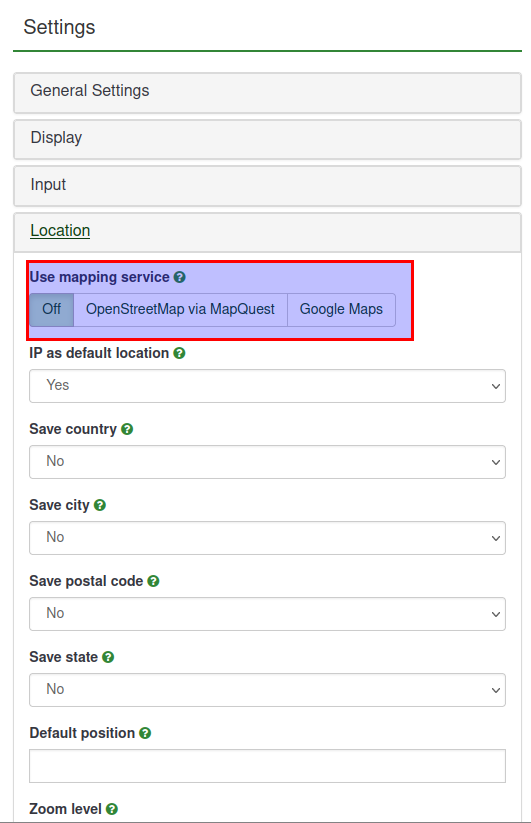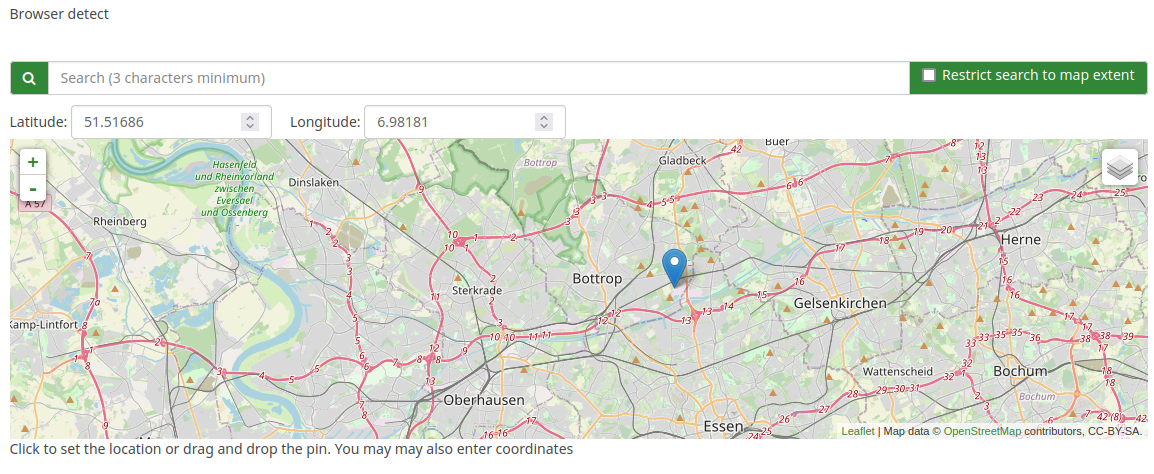Typy pytań
From LimeSurvey Manual
Wprowadzenie
Ta strona oferuje wizualny przegląd wszystkich dostępnych typów pytań. Można to również postrzegać jako punkt wyjścia, z którego można przejść do różnych sekcji wiki, które szczegółowo wyjaśniają każdy typ pytania.
Należy pamiętać, że ankieta LimeSurvey składa się z grup pytań zawierających jedno lub więcej pytań. Dlatego przed dodaniem pytań do ankiety należy „najpierw utworzyć grupę pytań”. Aby uzyskać więcej informacji na temat grup pytań, przeczytaj sekcja wiki.
Typy pytań
Aby zmienić typ pytania należy najpierw otworzyć pytanie w trybie edycji i kliknąć zakładkę 'Opcje ogólne znajdującą się w panelu po prawej stronie:

Następnie wybierz żądany typ pytania z menu „Wybierz typ pytania”. Aby mieć pewność, że wybierzesz właściwy typ pytania, w panelu „Wybierz typ pytania” wyświetlany jest podgląd typu pytania.
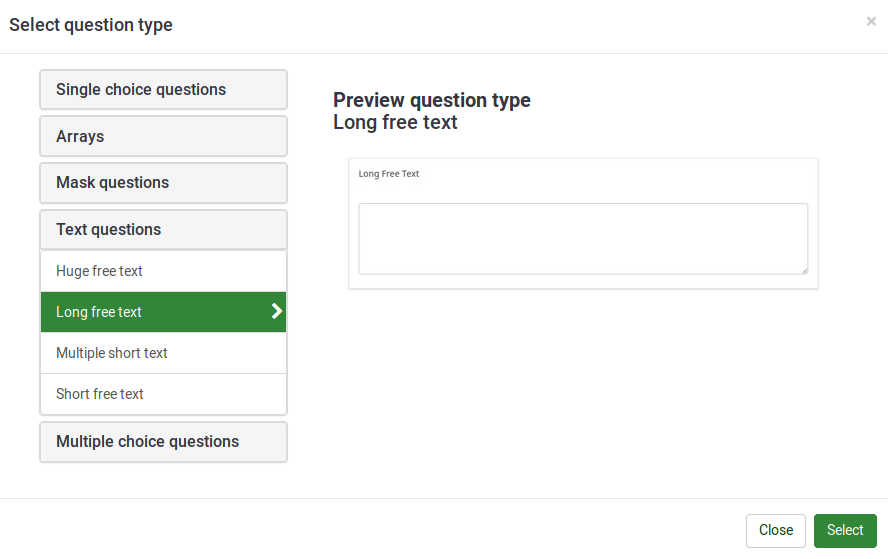
W ankiecie w LimeSurvey można używać następujących stylów pytań:
- Tablice
- Zamaskuj pytania
- Pytania wielokrotnego wyboru
- [ [Typy pytań#Pytania jednokrotnego wyboru|Pytania jednokrotnego wyboru]]
- Pytania tekstowe
Zapytania dodatkowe
Zwykle pytanie zawiera tylko odpowiedzi. Istnieją jednak pewne typy pytań (takie jak typ pytania Array), które w zasadzie stanowią podzbiór pytań, na które uczestnik ankiety może odpowiedzieć na każde pytanie dodatkowe (często przy użyciu wcześniej zdefiniowanej skali opcji odpowiedzi).
Bardziej złożonym przykładem jest pytanie typu „Tablica tekstów”, w którym respondent musi wprowadzić wartości kombinacji. W takim przypadku wartość wprowadzona przez respondenta jest „odpowiedzią”, a dwie skale w tablicy są dwiema skalami pytań dodatkowych.
Tablice
„Typ pytania tablicowego” stanowi dalsze rozszerzenie „Typu pytania typu lista”. Używając tego typu pytania, można wyświetlić macierz, w której lewa kolumna jest reprezentowana przez pytanie podrzędne, a każdy wiersz jest reprezentowany przez ten sam zestaw opcji odpowiedzi. Tekst pytania może być konkretnym pytaniem lub opisem.
Jeśli chodzi o wyniki, nie ma różnicy w sposobie przechowywania odpowiedzi w porównaniu z pytaniem typu „Lista (Radio)”. Podana odpowiedź zapisywana jest w osobnej kolumnie tabeli wyników dla obu typów pytań.
Najbardziej elastyczne typy tablic to „Array”, „Array (Text)” i „Array (Numbers)”. Jednak LimeSurvey obsługuje także wiele typów tablic, które mają predefiniowane opcje odpowiedzi (np. „Wybór tablicy 5-punktowej”).
Tablica
Przykład 1: Question type - Array using flexible labels.zip
Przykład 2: Question type - Array - Semantic Differential Question Type.zip
Dowiedz się więcej o typie pytania Tablica...
Tablica (wybór 5 punktów)
Typ pytania – tablica (wybór za 5 punktów)
Dowiedz się więcej o typie pytania typu tablica za 5 punktów do wyboru...
Tablica (wybór 10 punktów)
Typ pytania – tablica (wybór za 10 punktów)
Dowiedz się więcej o typie pytania za pomocą Tablicy wyboru za 10 punktów...
Tablica (Tak/Nie/Niepewne)
Typ pytania - tablica (tak-nie-niepewny)
Dowiedz się więcej o typie pytania Tak/Nie/Niepewny Tablica...
Tablica (zwiększ/tak samo/zmniejsz)
Typ pytania - tablica (zwiększenie-tak samo-zmniejszenie)
Dowiedz się więcej o typie pytania Zwiększ/Tak samo/Zmniejsz tablicę...
Tablica według kolumn
Typ pytania — tablica według kolumny
Dowiedz się więcej o typie pytania Tablica według kolumny...
Podwójna skala tablicy
Typ pytania — tablica z podwójną skalą
Dowiedz się więcej o typie pytania Array Dual Scale...
Tablica (Liczby)
Typ pytania – tablica (liczby)
Dowiedz się więcej o liczbach Typ pytania Tablica...
Tablica (teksty)
Typ pytania – tablica (teksty)
Dowiedz się więcej o tekście Typ pytania Tablica...
Zamaskuj pytania
Z braku lepszego terminu wszystkie pytania, w przypadku których wprowadzanie odpowiedzi jest z góry określone, definiujemy jako „pytania maskujące”.
Data
Dowiedz się więcej o pytaniu typu Data...
Przesyłanie pliku
Typ pytania — przesyłanie pliku
Dowiedz się więcej o typie pytania dotyczącym przesyłania pliku...
Płeć
Możesz także dodać opcję „Brak odpowiedzi”, jeśli pytanie nie jest obowiązkowe.
Dowiedz się więcej o pytaniu typu Płeć...
Przełącznik języka
Dowiedz się więcej o typie pytania Zmiana języka...
Wprowadzanie numeryczne
Dowiedz się więcej o typie pytania Wprowadzanie numeryczne...
Wprowadzanie wielu liczb
Typ pytania — wprowadzenie wielu liczb
Dowiedz się więcej o pytaniu typu wielokrotne wprowadzanie liczbowe...
Ranking
Dowiedz się więcej o typie pytania Ranking...
Zaawansowany ranking (nowość w wersji 5.x)
Ten typ pytania pozwala zaprezentować uczestnikom ankiety listę możliwych odpowiedzi/opcji w formie obrazu, którą mogą następnie uszeregować zgodnie ze swoimi preferencjami.
Wyświetlanie tekstu
Typ pytania — wyświetlanie tekstu
Dowiedz się więcej o typie pytania Wyświetlanie tekstu...
Tak/Nie
Dowiedz się więcej o typie pytania Tak/Nie...
Równanie
Dowiedz się więcej o pytaniu typu Równanie...
Pytania wielokrotnego wyboru
Czasami chcesz, aby uczestnik zaznaczył więcej niż jedną opcję odpowiedzi w tym samym pytaniu; osiąga się to za pomocą pól wyboru.
Wielokrotny wybór
Typ pytania - wielokrotny wybór
Find out more about the Multiple Choice Question type...
Multiple choice with comments
This question type can collect input of multiple selections through checkboxes, while allowing the user to provide additional comments.
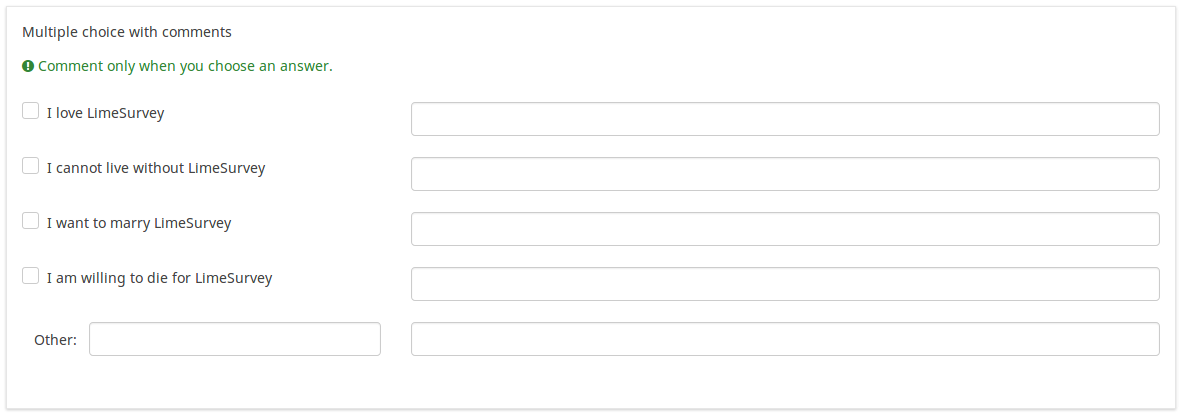
Example: Multiple choice with questions example.zip
Find out more about the Multiple Choice With Comments question type...
Bootstrap Buttons (new in 5.x)
This question type can collect input of multiple selections using a bootstrap button. Respondent can click and then it is selected.
Image Select Multiple Choice (new in 5.x)
This question type can collect input of multiple selections using an image. Respondent can click and then the image is selected.
The images must be first imported using the resources link on the survey settings. Then the images can be selected as the image to use for the sub-questions using the HTML editor.
Single choice questions
Single choice questions are those where the participant can only pick a single predefined answer option.
5 point choice
This question shows a horizontal 1 to 5 scale from where the survey participants can select a single answer option.
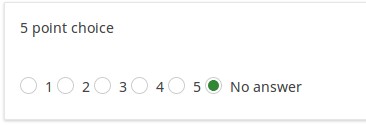
Example: Single choice question example.zip
Find out more about the 5 Point Choice question type...
List (Dropdown)
This question type collects input from a dropdown list menu. You can also create subcategories within this list by making use of the "Category separator" attribute.
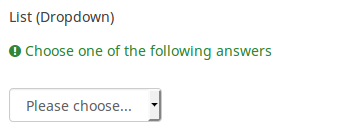
Example: List dropdown question.zip
Find out more about the List Dropdown question type...
List (Radio)
This question type collects input from a list of radio buttons.
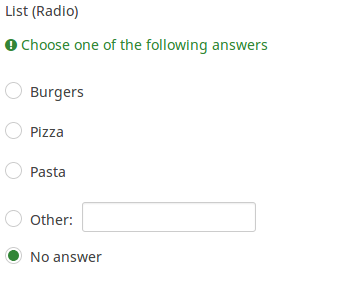
Example: List_radio_example.zip
Find out more about the List Radio question type...
List with comment
This question type displays a list of radio buttons, while allowing the participants to provide a additional comment with their submission.

Example: List_with_comment_example.zip
Find out more about the List with comment question type...
Image Select List (Radio) (New in 5.x)
This question type will allow you to collect single input from a list of images.
The images can be added using the sub-question HTML Editor.
Bootstrap Button (New in 5.x)
This question type collects single input from a list of bootstrap buttons.
Text questions
LimeSurvey provides a number of possible variations of the standard text field. All of these can be defined further using the attributes of the question which permit to restrict the number of characters as well as the size of the field.
Furthermore text input can be validated by using regular expressions.
Short free text
This question type collects a single line of text input.

Example: Short_free_text_question.zip
Find out more about the Short Free Text question type...
Long free text
This question type collects multiple lines of text input.

Example: Long_free_text_example.zip
Find out more about the Long Free Text question type...
Huge free text
This question type collect multiple lines of text input, allowing more text to be typed in.

Example: Huge_free_text_example.zip
Find out more about the Huge Free Text question type...
Multiple short text
This question type is a variation on the "Short Text" question type which allows more than one text entry per question. The user first defines the question and can then add additional text boxes by adding 'Answers'. Each answer becomes the label of the new text box.

Example: Multiple_short_text_example.zip
Find out more about the Multiple Short Text question type...
Browser Detect (new in 5.x)
The browser detects question type captures the browser the respondent is using and the operating system.
When the "use mapping services" is enabled, then there will be a map displayed.
Note: To use google maps, a valid Google Maps API key must be inserted into the field available in the global settings of your installation.
Respondents can use the pin to select a location on the map.
Input on Demand (new in 5.x)
The input on demand displays one column at a time and respondents can use the add button to add more answers. Other options are available. Use the question settings to add more options.
Styling questions
It is possible to edit the question layout/design by using CSS. You can find more information at styling questions with CSS


